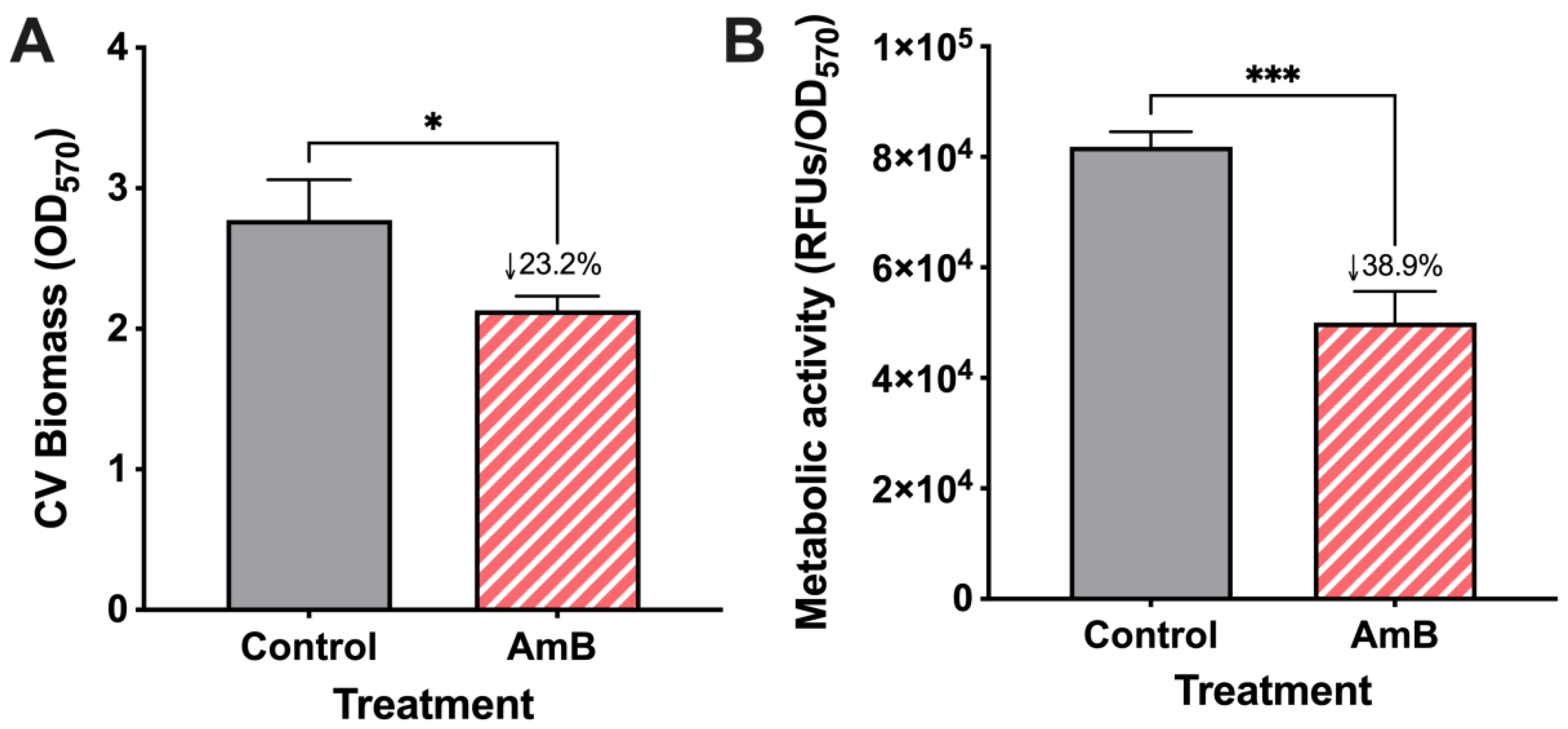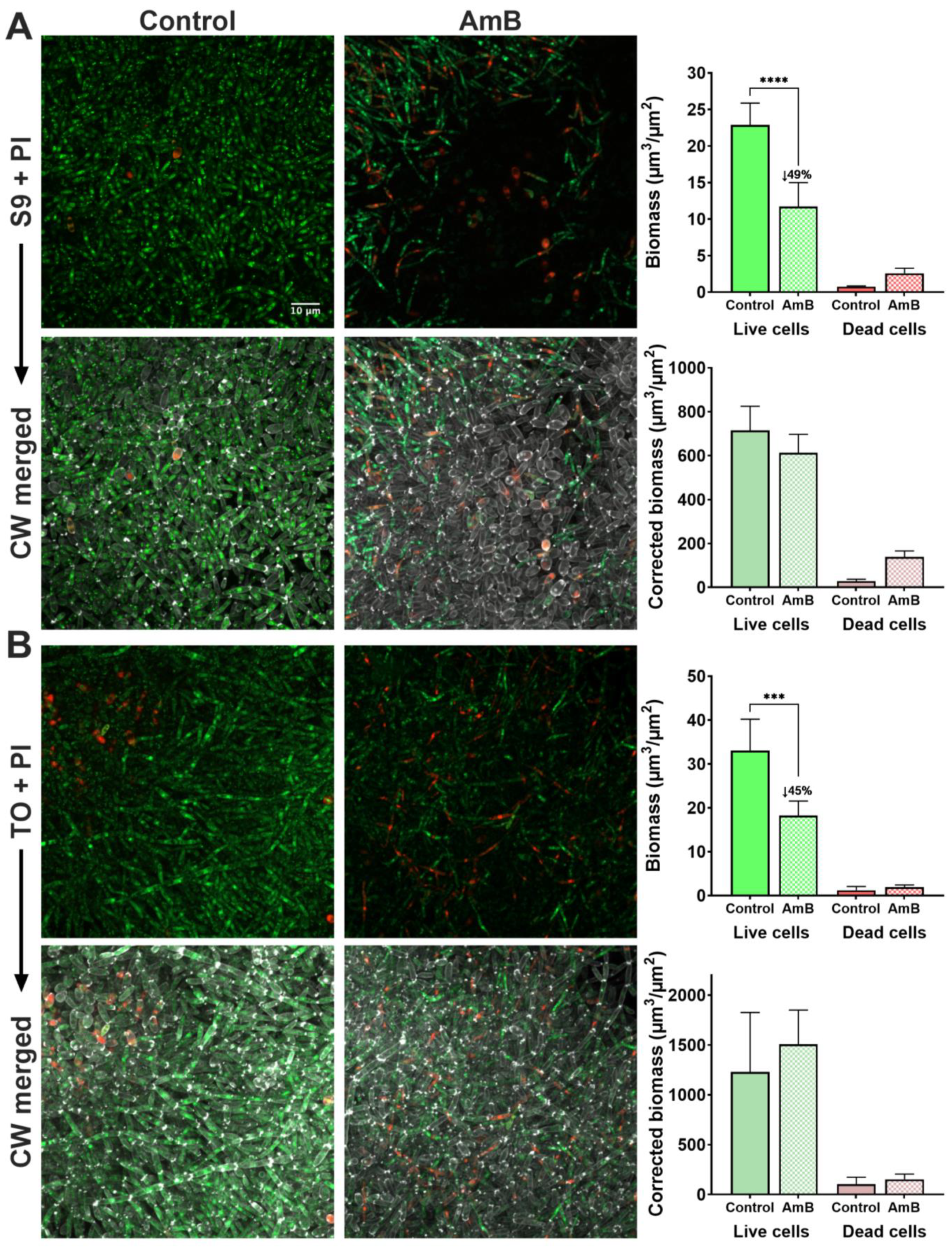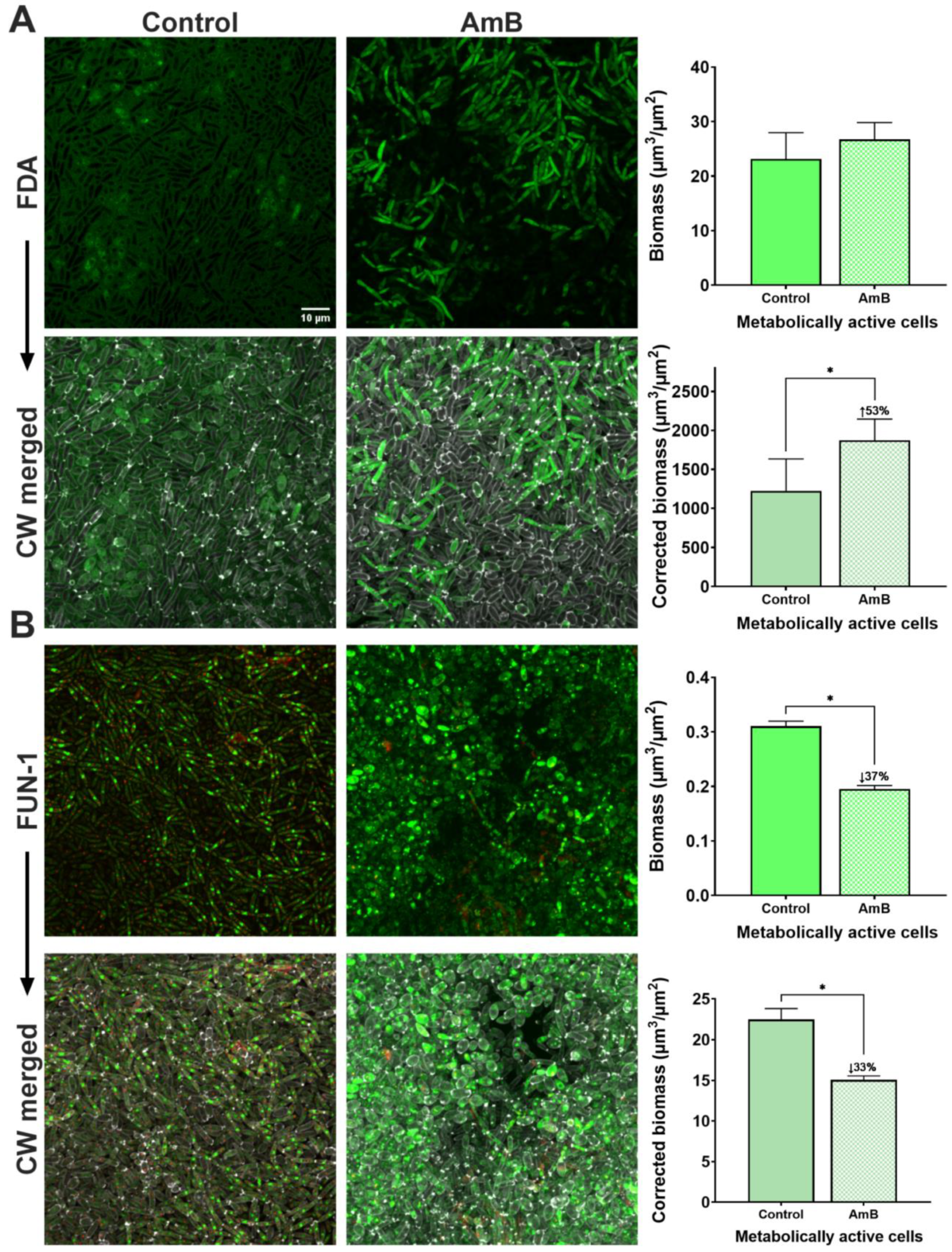Died or Not Dyed: Assessment of Viability and Vitality Dyes on Planktonic Cells and Biofilms from Candida parapsilosis
Abstract
1. Introduction
2. Results
2.1. Viability and Vitality Staining of C. parapsilosis 11103595 Overnight Cultures
2.2. Total Biomass and Metabolic Activity of C. parapsilosis 11103595 Biofilms Treated with AmB
2.3. Viability and Vitality Staining of C. parapsilosis 11103595 Biofilms Treated with AmB
3. Discussion
4. Materials and Methods
4.1. Bacterial Strains and Growing Conditions
4.2. Biofilm Formation on Silicon Coupons
4.3. Biofilm Total Biomass and Metabolic Activity
4.4. Dyes Evaluation
4.5. Quantification and Statistical Analysis
Author Contributions
Funding
Institutional Review Board Statement
Informed Consent Statement
Data Availability Statement
Acknowledgments
Conflicts of Interest
References
- Sharma, M.; Chakrabarti, A. Candidiasis and other emerging yeasts. Curr. Fungal Infect. Rep. 2023, 17, 15–24. [Google Scholar] [CrossRef] [PubMed]
- Pendleton, K.M.; Huffnagle, G.B.; Dickson, R.P. The significance of Candida in the human respiratory tract: Our evolving understanding. Pathog. Dis. 2017, 75, ftx029. [Google Scholar] [CrossRef]
- Tóth, R.; Nosek, J.; Mora-Montes Héctor, M.; Gabaldon, T.; Bliss Joseph, M.; Nosanchuk Joshua, D.; Turner Siobhán, A.; Butler, G.; Vágvölgyi, C.; Gácser, A. Candida parapsilosis: From genes to the bedside. Clin. Microbiol. Rev. 2019, 32, e00111-18. [Google Scholar] [CrossRef] [PubMed]
- Kwolek-Mirek, M.; Zadrag-Tecza, R. Comparison of methods used for assessing the viability and vitality of yeast cells. FEMS Yeast Res. 2014, 14, 1068–1079. [Google Scholar] [CrossRef] [PubMed]
- Bettauer, V.; Costa Anna Carolina Borges, P.; Omran Raha, P.; Massahi, S.; Kirbizakis, E.; Simpson, S.; Dumeaux, V.; Law, C.; Whiteway, M.; Hallett Michael, T. A Deep Learning Approach to Capture the Essence of Candida albicans Morphologies. Microbiol. Spectr. 2022, 10, e01472-22. [Google Scholar] [CrossRef] [PubMed]
- Gil, C.; Pomés, R.; Nombela, C. Isolation and characterization of Candida albicans morphological mutants derepressed for the formation of filamentous hypha-type structures. J. Bacteriol. 1990, 172, 2384–2391. [Google Scholar] [CrossRef] [PubMed]
- Bahamondez-Canas, T.F.; Heersema, L.A.; Smyth, H.D.C. Current Status of In Vitro Models and Assays for Susceptibility Testing for Wound Biofilm Infections. Biomedicines 2019, 7, 34. [Google Scholar] [CrossRef]
- Wilson, C.; Lukowicz, R.; Merchant, S.; Valquier-Flynn, H.; Caballero, J.; Sandoval, J.; Okuom, M.; Huber, C.; Brooks, T.D.; Wilson, E.; et al. Quantitative and Qualitative Assessment Methods for Biofilm Growth: A Mini-review. Res. Rev. J. Eng. Technol. 2017, 6, 1–25. Available online: http://www.rroij.com/open-access/quantitative-and-qualitative-assessment-methods-for-biofilm-growth-a-minireview-.pdf (accessed on 20 February 2024).
- Branco, J.; Miranda, I.M.; Rodrigues, A.G. Candida parapsilosis Virulence and Antifungal Resistance Mechanisms: A Comprehensive Review of Key Determinants. J. Fungi 2023, 9, 80. [Google Scholar] [CrossRef]
- Mountcastle, S.E.; Vyas, N.; Villapun, V.M.; Cox, S.C.; Jabbari, S.; Sammons, R.L.; Shelton, R.M.; Walmsley, A.D.; Kuehne, S.A. Biofilm viability checker: An open-source tool for automated biofilm viability analysis from confocal microscopy images. NPJ Biofilms Microbiomes 2021, 7, 44. [Google Scholar] [CrossRef]
- Raas, M.W.D.; Silva, T.P.; Freitas, J.C.O.; Campos, L.M.; Fabri, R.L.; Melo, R.C.N. Whole slide imaging is a high-throughput method to assess Candida biofilm formation. Microbiol. Res. 2021, 250, 126806. [Google Scholar] [CrossRef] [PubMed]
- Cai, J.; Xiong, H.; Cao, M.; Liu, L.; Zhang, L.; Wang, Q. Progressive Attention Guidance for Whole Slide Vulvovaginal Candidiasis Screening. In Proceedings of the Medical Image Computing and Computer Assisted Intervention—MICCAI 2023, Cham, Switzerland, 8–12 October 2023; pp. 233–242. [Google Scholar]
- Song, D.; Liu, H.; Huang, Y.; Dongari-Bagtzoglou, A.; Lei, Y. High-Throughput Monitoring of Pathogenic Fungal Growth Using Whole Slide Imaging for Rapid Antifungal Susceptibility Assessment. Anal. Lett. 2023, 1–14. [Google Scholar] [CrossRef]
- Tsutsumi-Arai, C.; Terada-Ito, C.; Tatehara, S.; Imamura, T.; Takebe, Y.; Ide, S.; Satomura, K. Fungicidal activity of grapefruit seed extract against the pathogenic Candida species causing oral candidiasis. J. Oral Maxillofac. Surg. Med. Pathol. 2021, 33, 626–632. [Google Scholar] [CrossRef]
- Reddy, G.K.K.; Kumar, P.H.; Padmavathi, A.R.; Kutala, V.K.; Sandur, S.K.; Nancharaiah, Y.V. Antifungal and antibiofilm action of triphenylphosphonium-conjugated curcumin on Candida albicans: Efficacy and activity mechanisms. Int. Biodeterior. Biodegrad. 2024, 189, 105751. [Google Scholar] [CrossRef]
- Zhang, Q.; Zhang, J.; Zhang, Y.; Sui, Y.; Du, Y.; Yang, L.; Yin, Y. Antifungal and anti-biofilm activities of patchouli alcohol against Candida albicans. Int. J. Med. Microbiol. 2024, 314, 151596. [Google Scholar] [CrossRef] [PubMed]
- Powell, L.C.; Adams, J.Y.M.; Quoraishi, S.; Py, C.; Oger, A.; Gazze, S.A.; Francis, L.W.; von Ruhland, C.; Owens, D.; Rye, P.D.; et al. Alginate oligosaccharides enhance the antifungal activity of nystatin against candidal biofilms. Front. Cell. Infect. Microbiol. 2023, 13, 1122340. [Google Scholar] [CrossRef] [PubMed]
- Cacaci, M.; Squitieri, D.; Palmieri, V.; Torelli, R.; Perini, G.; Campolo, M.; Di Vito, M.; Papi, M.; Posteraro, B.; Sanguinetti, M.; et al. Curcumin-Functionalized Graphene Oxide Strongly Prevents Candida parapsilosis Adhesion and Biofilm Formation. Pharmaceuticals 2023, 16, 275. [Google Scholar] [CrossRef]
- Zhu, B.; Li, Z.; Yin, H.; Hu, J.; Xue, Y.; Zhang, G.; Zheng, X.; Chen, W.; Hu, X. Synergistic Antibiofilm Effects of Pseudolaric Acid A Combined with Fluconazole against Candida albicans via Inhibition of Adhesion and Yeast-To-Hypha Transition. Microbiol. Spectr. 2022, 10, e01478-21. [Google Scholar] [CrossRef]
- Cheng, R.; Xu, Q.; Hu, F.; Li, H.; Yang, B.; Duan, Z.; Zhang, K.; Wu, J.; Li, W.; Luo, Z. Antifungal activity of MAF-1A peptide against Candida albicans. Int. Microbiol. 2021, 24, 233–242. [Google Scholar] [CrossRef]
- Ferreira, G.R.S.; Brito, J.d.S.; Procópio, T.F.; Santos, N.D.d.L.; de Lima, B.J.R.C.; Coelho, L.C.B.B.; Navarro, D.M.d.A.F.; Paiva, P.M.G.; Soares, T.; de Moura, M.C.; et al. Antimicrobial potential of Alpinia purpurata lectin (ApuL): Growth inhibitory action, synergistic effects in combination with antibiotics, and antibiofilm activity. Microb. Pathog. 2018, 124, 152–162. [Google Scholar] [CrossRef]
- Hifney, A.F.; Soliman, Z.; Ali, E.F.; Hussein, N.A. Microbial and microscopic investigations to assess the susceptibility of Candida parapsilosis and Prototheca ciferrii to phyco-synthesized titanium dioxide nanoparticles and antimicrobial drugs. S. Afr. J. Bot. 2022, 151, 791–799. [Google Scholar] [CrossRef]
- Lotfali, E.; Ghasemi, R.; Fattahi, A.; Keymaram, M.; Shafiei, M.; Norouzi, M.; Ayatollahi, A. Activities of Nanoparticles Against Fluconazole-Resistant Candida parapsilosis in Clinical Isolates. ASSAY Drug Dev. Technol. 2021, 19, 501–507. [Google Scholar] [CrossRef] [PubMed]
- Bizerra Fernando, C.; Melo Analy, S.A.; Katchburian, E.; Freymüller, E.; Straus Anita, H.; Takahashi Hélio, K.; Colombo Arnaldo, L. Changes in Cell Wall Synthesis and Ultrastructure during Paradoxical Growth Effect of Caspofungin on Four Different Candida Species. Antimicrob. Agents Chemother. 2011, 55, 302–310. [Google Scholar] [CrossRef] [PubMed]
- Dias, L.P.; Santos, A.L.E.; Araújo, N.M.S.; Silva, R.R.S.; Santos, M.H.C.; Roma, R.R.; Rocha, B.A.M.; Oliveira, J.T.A.; Teixeira, C.S. Machaerium acutifolium lectin alters membrane structure and induces ROS production in Candida parapsilosis. International J. Biol. Macromol. 2020, 163, 19–25. [Google Scholar] [CrossRef] [PubMed]
- Malveira, E.A.; Souza, P.F.N.; Neto, N.A.S.; Aguiar, T.K.B.; Rodrigues, N.S.; Henrique, C.W.B.; Silva, A.F.B.; Lima, L.B.; Albuquerque, C.C.; Freitas, C.D.T. Essential Oil from Croton blanchetianus Leaves: Anticandidal Potential and Mechanisms of Action. J. Fungi 2022, 8, 1147. [Google Scholar] [CrossRef] [PubMed]
- Li, Z.; Zhu, B.; Chen, W.; Hu, J.; Xue, Y.; Yin, H.; Hu, X.; Liu, W. Pseudolaric Acid A: A Promising Antifungal Agent Against Prevalent Non-albicans Candida Species. Infect. Drug Resist. 2023, 16, 5953–5964. [Google Scholar] [CrossRef] [PubMed]
- Hu, L.; Zhou, P.; Zhao, W.; Hua, H.; Yan, Z. Fluorescence staining vs. routine KOH smear for rapid diagnosis of oral candidiasis—A diagnostic test. Oral Dis. 2020, 26, 941–947. [Google Scholar] [CrossRef]
- Jahanshahi, G.; Shirani, S. Detection of Candida albicans in oral squamous cell carcinoma by fluorescence staining technique. Dent. Res. J. 2015, 12, 115. [Google Scholar]
- Nunes, T.S.; Rosa, L.M.; Vega-Chacón, Y.; Mima, E.G. Fungistatic Action of N-Acetylcysteine on Candida albicans Biofilms and Its Interaction with Antifungal Agents. Microorganisms 2020, 8, 980. [Google Scholar] [CrossRef]
- Abi-Chacra, É.A.; Souza, L.O.P.; Cruz, L.P.; Braga-Silva, L.A.; Gonçalves, D.S.; Sodré, C.L.; Ribeiro, M.D.; Seabra, S.H.; Figueiredo-Carvalho, M.H.G.; Barbedo, L.S.; et al. Phenotypical properties associated with virulence from clinical isolates belonging to the Candida parapsilosis complex. FEMS Yeast Res. 2013, 13, 831–848. [Google Scholar] [CrossRef]
- McGoverin, C.; Robertson, J.; Jonmohamadi, Y.; Swift, S.; Vanholsbeeck, F. Species dependence of SYTO 9 staining of bacteria. Front. Microbiol. 2020, 11, 545419. [Google Scholar] [CrossRef] [PubMed]
- Mesa-Arango, A.C.; Rueda, C.; Román, E.; Quintin, J.; Terrón María, C.; Luque, D.; Netea Mihai, G.; Pla, J.; Zaragoza, O. Cell wall changes in Amphotericin B-resistant strains from Candida tropicalis and relationship with the immune responses elicited by the host. Antimicrob. Agents Chemother. 2016, 60, 2326–2335. [Google Scholar] [CrossRef]
- Cho, O.; Takada, S.; Odaka, T.; Futamura, S.; Kurakado, S.; Sugita, T. Tacrolimus (FK506) Exhibits Fungicidal Effects against Candida parapsilosis Sensu Stricto via Inducing Apoptosis. J. Fungi 2023, 9, 778. [Google Scholar] [CrossRef] [PubMed]
- Miranda-Cadena, K.; Marcos-Arias, C.; Mateo, E.; Aguirre-Urizar, J.M.; Quindós, G.; Eraso, E. In vitro activities of carvacrol, cinnamaldehyde and thymol against Candida biofilms. Biomed. Pharmacother. 2021, 143, 112218. [Google Scholar] [CrossRef] [PubMed]
- Coenye, T. Biofilm antimicrobial susceptibility testing: Where are we and where could we be going? Clin. Microbiol. Rev. 2023, 36, e00024-23. [Google Scholar] [CrossRef] [PubMed]
- Alcàcer-Almansa, J.; Arévalo-Jaimes, B.V.; Blanco-Cabra, N.; Torrents, E. Methods for studying biofilms: Microfluidics and translation in the clinical context. In Methods in Microbiology; Academic Press: Cambridge, MA, USA, 2023. [Google Scholar]
- Marcos-Zambrano, L.J.; Escribano, P.; Bouza, E.; Guinea, J. Production of biofilm by Candida and non-Candida spp. isolates causing fungemia: Comparison of biomass production and metabolic activity and development of cut-off points. Int. J. Med. Microbiol. 2014, 304, 1192–1198. [Google Scholar] [CrossRef]
- Madeira, P.L.B.; Carvalho, L.T.; Paschoal, M.A.B.; de Sousa, E.M.; Moffa, E.B.; da Silva, M.A.d.S.; Tavarez, R.d.J.R.; Gonçalves, L.M. In vitro effects of lemongrass extract on Candida albicans biofilms, human cells viability, and denture surface. Front. Cell Infect. Microbiol. 2016, 6, 71. [Google Scholar] [CrossRef] [PubMed]
- Maione, A.; Bellavita, R.; de Alteriis, E.; Galdiero, S.; Albarano, L.; La Pietra, A.; Guida, M.; Parrilli, E.; D’Angelo, C.; Galdiero, E.; et al. WMR peptide as antifungal and antibiofilm against albicans and Non-albicans Candida species: Shreds of evidence on the mechanism of action. Int. J. Mol. Sci. 2022, 23, 2151. [Google Scholar] [CrossRef]
- Seneviratne, C.J.; Silva, W.J.; Jin, L.J.; Samaranayake, Y.H.; Samaranayake, L.P. Architectural analysis, viability assessment and growth kinetics of Candida albicans and Candida glabrata biofilms. Arch. Oral Biol. 2009, 54, 1052–1060. [Google Scholar] [CrossRef]
- Honraet, K.; Goetghebeur, E.; Nelis, H.J. Comparison of three assays for the quantification of Candida biomass in suspension and CDC reactor grown biofilms. J. Microbiol. Methods 2005, 63, 287–295. [Google Scholar] [CrossRef]
- Köhler, G.A.; Assefa, S.; Reid, G. Probiotic interference of Lactobacillus rhamnosus GR-1 and Lactobacillus reuteri RC-14 with the opportunistic fungal pathogen Candida albicans. Infect. Dis. Obstet. Gynecol. 2012, 2012, 636474. [Google Scholar] [CrossRef] [PubMed]
- Mishra, N.N.; Ali, S.; Shukla, P.K. Arachidonic acid affects biofilm formation and PGE2 level in Candida albicans and non-albicans species in presence of subinhibitory concentration of fluconazole and terbinafine. Braz. J. Infect. Dis. 2014, 18, 287–293. [Google Scholar] [CrossRef] [PubMed]
- Al-Dhaheri, R.S.; Douglas, L.J. Apoptosis in Candida biofilms exposed to amphotericin B. J. Med. Microbiol. 2010, 59, 149–157. [Google Scholar] [CrossRef]
- Millard, P.J.; Roth, B.L.; Thi, H.P.; Yue, S.T.; Haugland, R.P. Development of the FUN-1 family of fluorescent probes for vacuole labeling and viability testing of yeasts. Appl. Environ. Microbiol. 1997, 63, 2897–2905. [Google Scholar] [CrossRef] [PubMed]
- Schindelin, J.; Arganda-Carreras, I.; Frise, E.; Kaynig, V.; Longair, M.; Pietzsch, T.; Preibisch, S.; Rueden, C.; Saalfeld, S.; Schmid, B. Fiji: An open-source platform for biological-image analysis. Nat. Methods 2012, 9, 676–682. [Google Scholar] [CrossRef] [PubMed]
- Schneider, C.A.; Rasband, W.S.; Eliceiri, K.W. NIH Image to ImageJ: 25 years of image analysis. Nat. Methods 2012, 9, 671–675. [Google Scholar] [CrossRef] [PubMed]
- Heydorn, A.; Nielsen, A.T.; Hentzer, M.; Sternberg, C.; Givskov, M.; Ersboll, B.K.; Molin, S. Quantification of biofilm structures by the novel computer program COMSTAT. Microbiology 2000, 146, 2395–2407. [Google Scholar] [CrossRef]
- Vorregaard, M. Comstat2—A Modern 3D Image Analysis Environment for Biofilms; Technical University of Denmark: Lyngby, Denmark, 2008. [Google Scholar]




| Evaluated Dye | Non-Treated Biofilms | AmB-Treated Biofilms | Change (%) |
|---|---|---|---|
| %Viability (live cells biomass/(live cells biomass + dead biomass)) | |||
| S9–PI | 96.6 ± 0.3 | 81.9 ± 2.9 | −15.2 ± 2.8 |
| TO–PI | 94.9 ± 3.7 | 89.1 ± 1.4 | −6 ± 2.6 |
| Metabolically active biomass (µm3/µm2) | |||
| FDA | 23.1 ± 4.8 | 26.8 ± 3.1 | +17.1 ± 10.5 |
| FUN-1 1 | 31.1 ± 0.9 | 19.5 ± 0.6 | −37.1 ± 1.1 |
Disclaimer/Publisher’s Note: The statements, opinions and data contained in all publications are solely those of the individual author(s) and contributor(s) and not of MDPI and/or the editor(s). MDPI and/or the editor(s) disclaim responsibility for any injury to people or property resulting from any ideas, methods, instructions or products referred to in the content. |
© 2024 by the authors. Licensee MDPI, Basel, Switzerland. This article is an open access article distributed under the terms and conditions of the Creative Commons Attribution (CC BY) license (https://creativecommons.org/licenses/by/4.0/).
Share and Cite
Arévalo-Jaimes, B.V.; Torrents, E. Died or Not Dyed: Assessment of Viability and Vitality Dyes on Planktonic Cells and Biofilms from Candida parapsilosis. J. Fungi 2024, 10, 209. https://doi.org/10.3390/jof10030209
Arévalo-Jaimes BV, Torrents E. Died or Not Dyed: Assessment of Viability and Vitality Dyes on Planktonic Cells and Biofilms from Candida parapsilosis. Journal of Fungi. 2024; 10(3):209. https://doi.org/10.3390/jof10030209
Chicago/Turabian StyleArévalo-Jaimes, Betsy Verónica, and Eduard Torrents. 2024. "Died or Not Dyed: Assessment of Viability and Vitality Dyes on Planktonic Cells and Biofilms from Candida parapsilosis" Journal of Fungi 10, no. 3: 209. https://doi.org/10.3390/jof10030209
APA StyleArévalo-Jaimes, B. V., & Torrents, E. (2024). Died or Not Dyed: Assessment of Viability and Vitality Dyes on Planktonic Cells and Biofilms from Candida parapsilosis. Journal of Fungi, 10(3), 209. https://doi.org/10.3390/jof10030209






